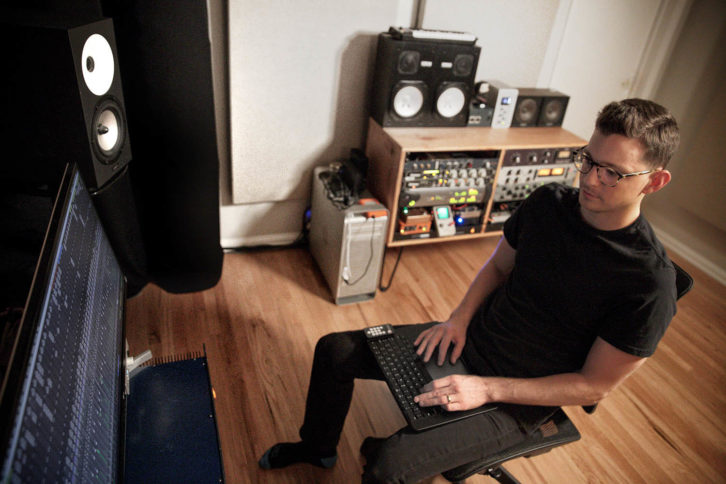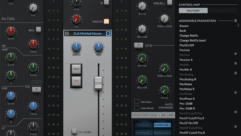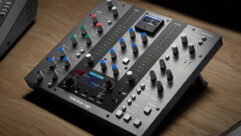SAFETY HARBOR, FLORIDA: Regarding his chosen profession, Grammy-nominated mix engineer Jesse Ray Ernster pleads that he really had no choice. “My dad produced and mixed in a studio in our house, so growing up I was surrounded by instruments and exposed to an endless parade of bands. My career choice wasn’t up to me. I caught the recording bug!” Ernster is passionate about good music irrespective of genre, and he spends his days bouncing between projects. A typical day may involve a rock record in the morning, a few hip-hop tracks in the afternoon, and an Afrobeat session in the evening. After years cutting his teeth as a recording engineer, most notably for Kayne West’ Yandhi and Jesus is King albums, Ernster has made the slow pivot to full-time mix engineer. He mixed Burna Boy’s African Giant, which earned a 2019 Grammy nomination for Best World Music Album. After many successful years using Metric Halo’s flagship plug-in ChannelStrip “on just about everything,” Ernster recently met the Metric Halo team at NAMM and expanded his Metric Halo plug-in pallet with the all-inclusive Production Bundle.
 “My friend Taylor Larson introduced me to Metric Halo ChannelStrip a few years ago,” Ernster explained. “The underlying algorithms used in ChannelStrip were developed by Metric Halo almost twenty years ago, and they still sound way better than the latest offerings from other pro audio software companies.” Ernster should know. He’s a self-proclaimed geek when it comes to pro audio gear and spends his downtime in the studio A/B-ing different equipment and approaches. “I love doing blind tests,” he said. “I’m forever looking for the next tool or technique that will give me an edge, and I try to remain objective about my choices. Truly, part of me wants to hold the Metric Halo plug-ins close as my secret weapon. But the better part of me wants to spread the word!”
“My friend Taylor Larson introduced me to Metric Halo ChannelStrip a few years ago,” Ernster explained. “The underlying algorithms used in ChannelStrip were developed by Metric Halo almost twenty years ago, and they still sound way better than the latest offerings from other pro audio software companies.” Ernster should know. He’s a self-proclaimed geek when it comes to pro audio gear and spends his downtime in the studio A/B-ing different equipment and approaches. “I love doing blind tests,” he said. “I’m forever looking for the next tool or technique that will give me an edge, and I try to remain objective about my choices. Truly, part of me wants to hold the Metric Halo plug-ins close as my secret weapon. But the better part of me wants to spread the word!”
Ernster is commonly called on for two related, but distinct mixing tasks. “Some artists and producers spend a lot of time working on a rough mix that is very close to dialed in, with effects and everything,” he said. “Burna Boy is a great example. He has perfect 20/20 sonic vision for how his project should sound. Nothing is accidental. In that situation, my job is to add the final polish without fundamentally altering the rough mix. On the other hand, some artists, like Lynch Mob, are really leaving a lot of room and trust for my own vision and creative approach to mixing their music. People who know my style know that I love giant, bombastic drums, so they might hand me rough mixes with nothing on the drums at all. It’s all up to me.”
Determining the difference between those two different expectations comes down to good communication early on. “If someone is expecting modest polish and I return a totally re-envisioned mix, they’ll be offended,” he said. “On the other hand, if someone expects big creative changes and I hand back modest polish, they’ll wonder if I want to work for my money! I establish those expectations early on, which makes the process more enjoyable and predictable for everyone involved.”
In either case, Ernster will be expected to shape individual tracks in the frequency and dynamics domains, tasks that are perfectly suited to Metric Halo ChannelStrip’s EQ and compression sections, as well as Metric Halo’s Multiband Dynamic plug-in. “I use ChannelStrip on everything,” he said. “While I’ve heard some people characterize it as sterile, I don’t perceive it that way. It sounds gorgeous and so broadband. The parameters are silky and responsive. I used ChannelStrip all over ‘African Giant.’ Burna gave me most of the vocal tracks with delays and reverbs printed in. Other compressors make those kinds of situations far worse, but ChannelStrip’s compressor is like having a tiny person inside the computer, turning things up and down by hand. It’s totally transparent.”
To achieve the kind of low-end pulse that drives a good rhythm section, Ernster relies on Metric Halo Multiband Dynamics and TransientControl. “With Multiband Dynamics, I can isolate the low end and dial in the attack and release to get the right kind of pulse and flex for a given tempo and instrumentation,” he said. “The sub pocket region has to be really happening, so I usually adjust the crossover down to 60 or 70Hz. I want space before the next hit, and the release is the most important parameter for that. In the end, I’m after more than just a big low end. Anybody can make it huge. I want it tight and controlled. Metric Halo TransientControl is also a powerhouse on drums. I did extensive blind A/B comparisons with TransientControl up against all of the other popular transient plug-ins – and even a famous hardware unit! I’m not sure if it’s Metric Halo’s oversampling, its algorithm, or both, but it won every time. Unlike all the other options out there, TransientControl increases the transients without bringing all that super annoying clacky, thwacky midrange forward.”
Ernster has also started using Metric Halo TransientControl at the front of his vocal chain. “I get a lot of vocals with amazing performances recorded in acoustic spaces that are far from amazing, like bedrooms and living rooms,” he said. “By the time I have compressed them enough to compete with modern productions, you can hear the echo and the acoustic environment. However, with TransientControl at the top of the chain, I can pull the sustain knob down and the vocalist is suddenly transported to a perfectly isolated vocal booth! It’s like a de-reverb plug-in. I’ve gotten a lot of comments from knowledgeable producers who are amazed at that trick – it’s totally impossible with standard processing tools.”
Metric Halo’s signal chain modeling and saturation plug-in, Character, is also usually high up on the list of Ernster’s recently-used plug-ins. He routinely uses it in parallel on vocals and drums. “Character is always the final touch,” he said. “I get the vocals or drums totally dialed in, then I send it to an aux with Character on it and drive the hell out of it. I flip through the different models – different models work better or worse depending on the source material – but I end up at one of the tube or FET models more often than not. Then I blend that track in under the vocal, or I often use Character as the main signal with the dry below. It’s a trick I used to use with my hardware 1176, but Character does a better job. Once I have the model and saturation set, I use volume automations to increase the drive in places where the song calls for more excitement.”
ABOUT METRIC HALO Based on the Gulf Coast of Florida, Metric Halo provides the world with award-winning software and hardware recording, processing, metering and analysis solutions.










